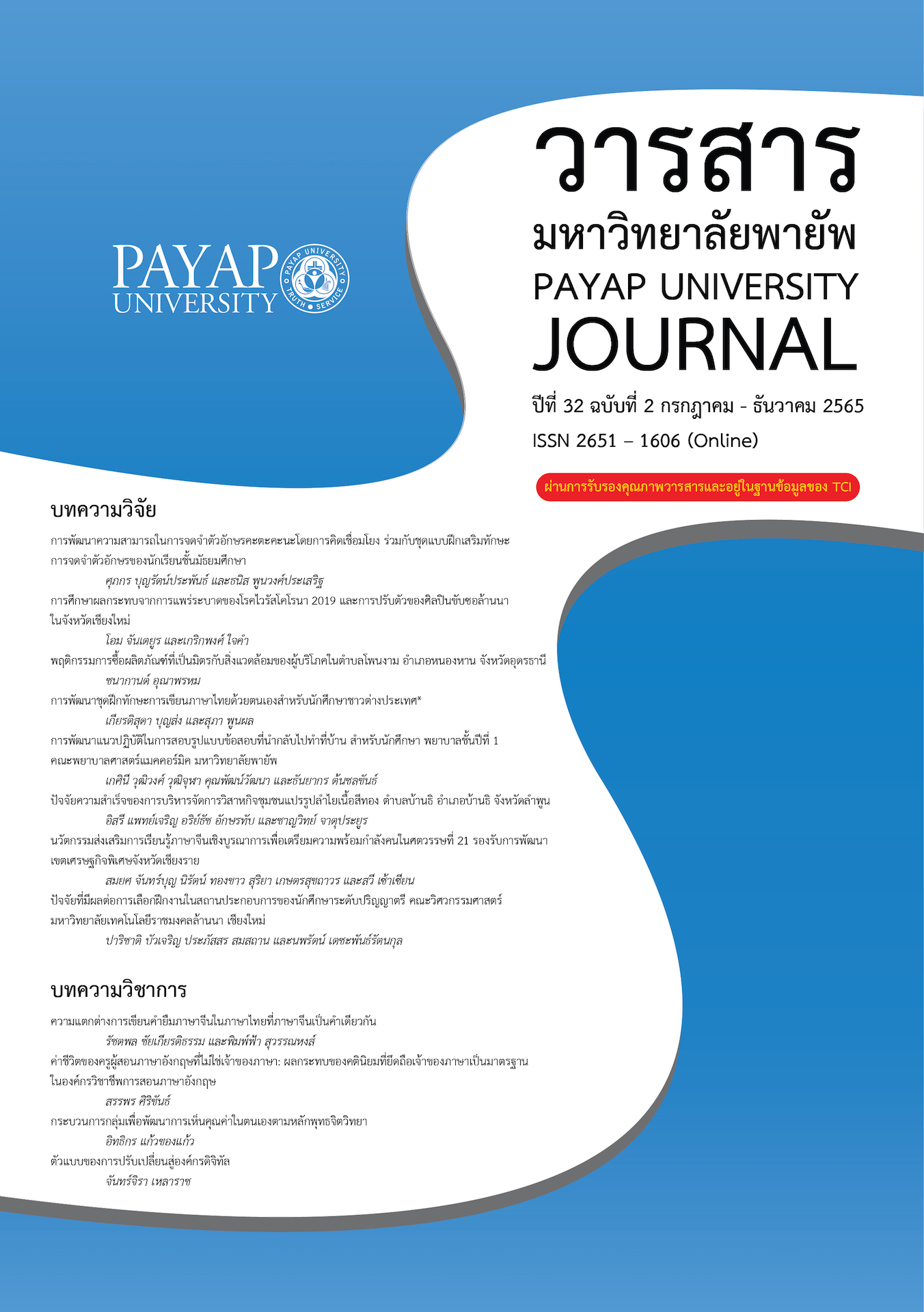นวัตกรรมส่งเสริมการเรียนรู้ภาษาจีนเชิงบูรณาการเพื่อเตรียมความพร้อมกำลังคนในศตวรรษที่ 21 รองรับการพัฒนาเขตเศรษฐกิจพิเศษจังหวัดเชียงราย
Main Article Content
บทคัดย่อ
การวิจัยนี้มีวัตถุประสงค์เพื่อสร้างและพัฒนาหนังสืออิเล็กทรอนิกส์ (E - book) และบทเรียนอีเลิร์นนิง (E - learning) ส่งเสริมการเรียนรู้ภาษาจีนเพื่อการสื่อสารด้านการท่องเที่ยว การค้าชายแดนและการบริการโลจิสติกส์ สำหรับประชาชนในเขตเศรษฐกิจพิเศษจังหวัดเชียงราย โดยกลุ่มตัวอย่างที่ใช้ในการเก็บข้อมูล ได้แก่ 1) กลุ่มตัวอย่างเก็บข้อมูลภาคสนามจำนวน 115 คน แบ่งเป็นกลุ่มตัวอย่างที่ตอบแบบสอบถามจำนวน 100 คน และกลุ่มตัวอย่างที่ตอบแบบสัมภาษณ์จำนวน 15 คน 2) กลุ่มตัวอย่างที่ใช้ในการทดสอบนวัตกรรมจำนวน 45 คน โดยกลุ่มตัวอย่างทั้งหมดคัดเลือกแบบเจาะจง เครื่องมือวิจัยคือ แบบสอบถาม แบบประเมินความพึงพอใจและแบบสัมภาษณ์ สถิติการวิเคราะห์ข้อมูล ได้แก่ ค่าเฉลี่ย ร้อยละ และค่าเบี่ยงเบนมาตรฐาน ผลการวิจัยพบว่า ผู้ประกอบการ ร้อยละ 85 มีปัญหาในการสื่อสารภาษาจีนด้านการท่องเที่ยว การค้าชายแดนและการบริการโลจิสติกส์ ผลการหาประสิทธิภาพของนวัตกรรมพบว่า การทดสอบแบบภาคสนาม (1:100) ตามเกณฑ์มาตรฐาน 80/80 ได้ค่า E1/E2 เท่ากับ 87.75/89.61 ซึ่งสูงกว่าเกณฑ์ที่กำหนดไว้และผลการประเมิน ความพึงพอใจต่อนวัตกรรมฯ คะแนนเฉลี่ยรวมอยู่ในระดับมากที่สุด ( = 4.66)
Article Details
เอกสารอ้างอิง
กนกพร ศรีญาณลักษณ์. (2550). การประยุกต์ใช้อีเลิร์นนิงในการเรียนการสอนภาษาจีน. วารสารศึกษาศาสตร์, 18(2), 33-48.
กองข้อมูลธุรกิจ กรมพัฒนาธุรกิจการค้า. (2564, 31 ธันวาคม). ข้อมูลธุรกิจเขตพัฒนาเศรษฐกิจพิเศษเชียงราย. https://www.dbd.go.th/download/document_file/Statisic/2564/ECONOMICZONE/Chiangrai.pdf
แกมกาญจน์ แสงหล่อ. (2560). การพัฒนาบทเรียนอีเลิร์นนิงวิชาภาษาอังกฤษเพื่อการสื่อสารตามสภาพแวดล้อมการเรียนส่วนบุคคลบนอินเทอร์เน็ตผ่านทางเครือข่ายสังคม สําหรับนักศึกษาปริญญาตรี. วารสารวิจัยทางการศึกษาคณะศึกษาศาสตร์ มหาวิทยาลัยศรีนครินทรวิโรฒ, 12(1), 286-299.
จินตวีร์ คล้ายสังข์. (2555). Desktop publishing สู่ e-book เพื่อส่งเสริมการใฝ่รู้ของผู้เรียนยุคดิจิทัล. จุฬาลงกรณ์มหาวิทยาลัย.
ชัยยงค์ พรหมวงศ์. (2556). การทดสอบประสิทธิภาพสื่อหรือชุดการสอน. วารสารศิลปากรศึกษาศาสตร์วิจัย, 5(1), 1-20.
บุญชม ศรีสะอาด. (2551). วิธีการทางสถิติสำหรับการวิจัย (พิมพ์ครั้งที่ 4). ประสานการพิมพ์.
วิวัฒน์ มีสุวรรณ์. (2561). วิจัยทางเทคโนโลยีการศึกษา. มหาวิทยาลัยนเรศวร.
ศยามน อินสะอาด. (2559). การออกแบบบทเรียนอีเลิร์นนิงเพื่อพัฒนาทักษะการคิดขั้นสูงระดับอุดมศึกษา. วารสาร Veridian E-Journal, Silpakorn University. 9(3). 906-922.
สมยศ จันทร์บุญ, นิรัตน์ ทองขาว, สุริยา เกษตรสุขถาวร, และพิชญ์ธัชกิต ธนวัฒน์โอภาส. (2562). การสร้างและพัฒนานวัตกรรมเพื่อส่งเสริมการสื่อสารภาษาจีนเบื้องต้นของผู้ประกอบการอิสระในเขตพื้นที่พัฒนาเศรษฐกิจพิเศษ อำเภอเชียงแสน จังหวัดเชียงราย รองรับการเป็นไทยแลนด์ 4.0. วารสารปัญญาภิวัฒน์, 11(3). 227-284.
สำนักงานคณะกรรมการพัฒนาการเศรษฐกิจและสังคมแห่งชาติ. (2560). แผนพัฒนาเศรษฐกิจและสังคมแห่งชาติฉบับที่ 12 (พ.ศ. 2560 - 2564). ผู้แต่ง. https://www.nesdc.go.th/ewt_w3c/ewt_dl_link.php?nid=6422
Huang, H. Y., ธนาพร ปัญญาอมรวัฒน์, และอนุช สุทธิธนกูล (2561). การพัฒนาเอกสารประกอบการสอนภาษาจีนเพื่อการสื่อสารสำหรับธุรกิจโทรคมนาคมและการประเมินผลการนำไปใช้. วารสารปัญญาภิวัฒน์, 10(2), 253-263.


